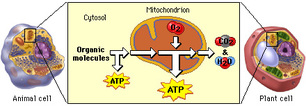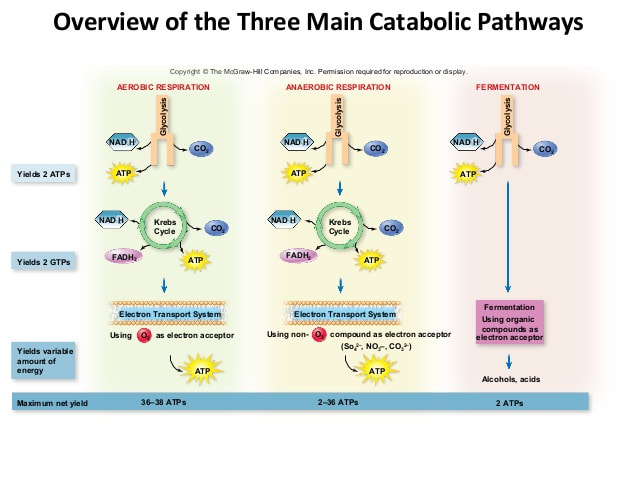topic 2.8: cellular respiration
 image from Pearson - The Biology Place
image from Pearson - The Biology Place
In the Cellular Respiration unit we will discuss aerobic and anaerobic cellular respiration. You will also learn how ATP is produced in the mitochondria.
The unit is planned to take 3 school days
The unit is planned to take 3 school days
Essential idea:
- Cell respiration supplies energy for the functions of life.
Nature of science:
- Assessing the ethics of scientific research—the use of invertebrates in respirometer experiments has ethical implications. (4.5)
- List ethical questions that must be considered before using animals in experiments.
- List ethical questions that must be considered before using animals in experiments.
Understanding
2.8.U1 Cell respiration is the controlled release of energy from organic compounds to produce ATP.
- Define “cell respiration.”
- State the reaction for cellular respiration.
- State the types of organic compounds used in cellular respiration by animals and plants.
Cell respiration is the controlled release of energy from organic compounds to produce ATP. The main organic compound used for this process is carbohydrates (glucose), although lipids and proteins can also be digested
There are two main types of cell respiration:
- organic compounds are broken down to release energy, which can be used in cells
- source of organic compounds broken down is food
- Carried out using enzymes carefully /controlled so that as much as possble is retained in a usable form
- Adenosine triphosphate – form is a chemical substance (ATP)
- Making ATP phosphate group is lined to ATP or ADP – energy to carry out the reaction comes from the breakdown of organic compounds
There are two main types of cell respiration:
- Anaerobic respiration involves the partial breakdown of glucose in the cytosol for a small yield of ATP
- Aerobic respiration utilises oxygen to completely break down glucose in the mitochondria for a larger ATP yield
2.8.U2 ATP from cell respiration is immediately available as a source of energy in the cell.
- State three example uses of cellular energy.
- Outline energy transfer in the formation and use of ATP.
- State three reasons why cellular respiration must be continuously performed by all cells.
ATP (adenosine triphosphate) is a high energy molecule that functions as an immediate source of power for cell processes
- Used to synthesizing large molecules like DNA, RNA, and proteins
- Pumping molecules or ions across membranes by active transport
- Moving things within a cell, like chromosomes, vesicles, muscles cells the protein fibres
- The energy is immediately available
- Released by splitting ATP into ADP and phosphate –> can be reconverted back to ATP through cell respiration.
- One molecule of ATP contains three covalently linked phosphate groups – which store potential energy in their bonds
- When ATP is hydrolysed (to form ADP + Pi) the energy stored in the phosphate bond is released to be used by the cell
- Cell respiration uses energy stored in organic molecules to regenerate ATP from ADP + Pi (via oxidation)Most energy is converted to heat within a cell – no reusable for cell activities/ eventually lost to the environment
- Reason way they need ATP because it’s continual
2.8.U3 Anaerobic cell respiration gives a small yield of ATP from glucose.
- Define “anaerobic respiration”
- List three situations in which anaerobic respiration is useful.
- Compare anaerobic respiration in yeasts and humans.
Both anaerobic and aerobic respiration pathways begin with the anaerobic breakdown of glucose in the cytosol by glycolysis
- glucose is broken down in anaerobic cell respiration without oxygen
- glycolysis breaks down glucose (6-C) into two molecules of pyruvate (3C), hydrogen carriers (NADH) from an oxidised precursor (NAD+)ATP yield is small but can be produced quickly (net gain of 2 molecules)
- when a short by fast burst of ATP production is needed
- when oxygen supplies run out in respiring cells
- in environments that are deficient in oxygen
- n animals, the pyruvate is converted into lactic acid (or lactate)
In plants and yeasts, the pyruvate is converted into ethanol and carbon dioxide
2.8.U4 Aerobic cell respiration requires oxygen and gives a large yield of ATP from glucose.
- Compare the total amount of ATP made from anaerobic and aerobic respiration.
- State the location of aerobic respiration.
if there’s oxygen then glucose can be more fully broken down to release a greater quantity of energy than in anaerobic cell respiration
- ATP two molecules per glucose in anaerobic cell respiration
- more then 30 per glucose in aerobic cell respiration
- Multiple chemical reactions – dioxide and water are produced
- eukaryotic cell- this happens inside the mitochondrion
Application
2.8.A1 Use of anaerobic cell respiration in yeasts to produce ethanol and carbon dioxide in baking.
- Outline how anaerobic respiration in yeast is used in baking.
- Outline how anaerobic respiration in yeast is used in ethanol production.
Some organisms such as yeasts only undergo anaerobic respiration and do not require Oxygen. During anaerobic respiration pyruvate from glycolysis is instead made into Lactate in animals, and Ethanol and Carbon Dioxide in yeast. This is why when yeast is added to aa cake bubbles form in the bread and the cake rises. Because of the Carbon Dioxide being produced.
2.8.A2 Lactate production in humans when anaerobic respiration is used to maximize the power of muscle contractions.
- State the condition in which humans would perform anaerobic respiration.
- Outline production of lactate in humans during anaerobic respiration.
Aerobic cell respiration requires oxygen and gives a large yield of ATP from glucose. Use of anaerobic cell respiration in yeasts to produce ethanol and carbon dioxide in baking. Lactate production in humans when anaerobic respiration is used to maximize the power of muscle contractions
Muscle contractions require the expenditure of high amounts of energy and thus require high levels of ATP. When exercising at high intensity, the cells’ energy demands will exceed what the available levels of O2 can supply aerobically. Therefore the body will begin breaking down glucose anaerobically to maximise ATP production. This will result in an increase in the production of lactic acid, which leads to muscle fatigue.
When the individual stops exercising, oxygen levels will increase and lactate will be converted back to pyruvate. Although carbohydrates, lipids and proteins can all be consumed as energy sources, only carbohydrates will typically undergo anaerobic respiration
Muscle contractions require the expenditure of high amounts of energy and thus require high levels of ATP. When exercising at high intensity, the cells’ energy demands will exceed what the available levels of O2 can supply aerobically. Therefore the body will begin breaking down glucose anaerobically to maximise ATP production. This will result in an increase in the production of lactic acid, which leads to muscle fatigue.
When the individual stops exercising, oxygen levels will increase and lactate will be converted back to pyruvate. Although carbohydrates, lipids and proteins can all be consumed as energy sources, only carbohydrates will typically undergo anaerobic respiration
Skill
2.8.S1 Analysis of results from experiments involving measurement of respiration rates in germinating seeds or invertebrates using a respirometer.
- Outline the use of a respirometer to measure cellular respiration rate.
A respirometer is a device that determines an organism’s respiration rate by measuring the rate of exchange of O2 and CO2. The living specimen (e.g. germinating seeds or invertebrate organism) is enclosed in a sealed container
Carbon dioxide production can be measured with a data logger or by pH changes if the specimen is immersed in water
When an alkali is included to absorb CO2, oxygen consumption can be measured as a change in pressure within the system. The pressure change can be detected with a data logger or via use of a U-tube manometer
Factors which may affect respiration rates include temperature, hydration, light (plants), age and activity levels
An increase in carbon dioxide levels will indicate an increase in respiration (CO2 is a product of aerobic respiration)
A decrease in oxygen levels will indicate an increase in respiration (O2 is a requirement for aerobic respiration)
Carbon dioxide production can be measured with a data logger or by pH changes if the specimen is immersed in water
When an alkali is included to absorb CO2, oxygen consumption can be measured as a change in pressure within the system. The pressure change can be detected with a data logger or via use of a U-tube manometer
Factors which may affect respiration rates include temperature, hydration, light (plants), age and activity levels
An increase in carbon dioxide levels will indicate an increase in respiration (CO2 is a product of aerobic respiration)
A decrease in oxygen levels will indicate an increase in respiration (O2 is a requirement for aerobic respiration)
Key Terms:
|
anaerobic respiration
covalent bond fermentation metabolise energy transfer respirometer carbon dioxide |
aerobic respiration
oxidation alcoholic Kreb Cycle yeast germination heat |
phosphate
pyruvate catalyse lactic acid acetyl-CoA ethanol |
mitochondria
glycolysis ethanol organic compounds lactate glucose |
ATP
ADP glucose yeast cell respiration muscle contractions |
Class Materials:
Aerobic Respiration
Fermentation
Yeast Fermentation Virtual Lab
Energy For Life worksheet
Cellular Respiration Lab
Gummy Bear demonstration (in class)
Topic 2.8 Review
Aerobic Respiration
Fermentation
Yeast Fermentation Virtual Lab
Energy For Life worksheet
Cellular Respiration Lab
Gummy Bear demonstration (in class)
Topic 2.8 Review
Powerpoint and Notes on Topic 2.8 by Chris Payne
Your browser does not support viewing this document. Click here to download the document.
Your browser does not support viewing this document. Click here to download the document.
Correct use of terminology is a key skill in Biology. It is essential to use key terms correctly when communicating your understanding, particularly in assessments. Use the quizlet flashcards or other tools such as learn, scatter, space race, speller and test to help you master the vocabulary.
External Links:
Whole Process
Virtual Cell's Educational Animations
Cellular Respiration
Inquiry into Biology - Metabolism
Click here for an animation on cellular respiration
Click here to view a micrograph of the mitochondria
Click here and enter the express code 4273P and click on Weblink 3.7
In the News:
Food Fermentation: The Science of Sausage and Cheese audio from Science Friday
New Study Sheds Light On Evolutionary Origin of Oxygen-Based Cellular Respiration Science Daily
Stem Cell Respiration Discovery
Video Clips:
In which Hank does some push ups for science and describes the "economy" of cellular respiration and the various processes whereby our bodies create energy in the form of ATP.
Paul Andersen covers the processes of aerobic and anaerobic cellular respiration. He starts with a brief description of the two processes. He then describes the important parts of the mitochondria. He explains how energy is transferred to ATP through the processes of glycolysis, the Kreb cycle and the Electron Transport Chain. He also explains how organisms use both lactic acid and alcoholic fermentation.
Cellular Rap






